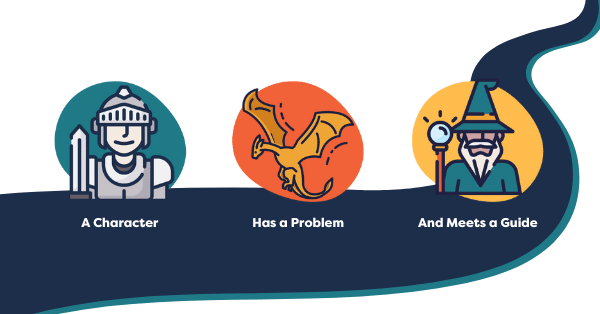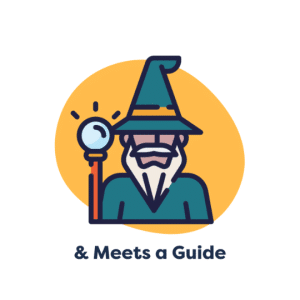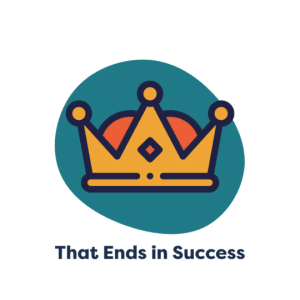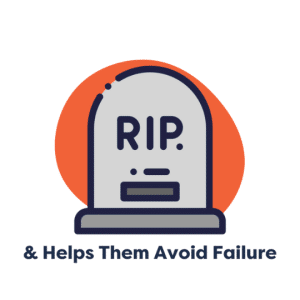1 Million 5-star Reviews. A++ BBB. Certified in All the Things. 50 Years in the Business.
As business owners, we tend to focus on what makes our business great. What makes us the right choice. How we’re going to save the day.
And it seems like that makes sense. After all, don’t you need to sell people on the fact that you’re good at your job?
Sure. A little bit.
But the reality is: you’re not the hero of this story.
Your customer is.
And when businesses pump themselves up as if they are the hero, potential customers lose interest.
It’s sort of like, “I get it, you’re qualified. But can you help me?”
Shift Your Focus to the Customer
So, how do you show potential customers that you get them and can help?
You tell their story instead. A great tool for helping you shift your focus is StoryBrand from Donald Miller.
It’s an exercise that puts you in your ideal customer’s shoes – and “casts” them as the hero in your business’s story.
What does that mean?
Let’s break it down.
- We tell the story of a character (your target customer) who has a problem.
- They then meet a guide (that’s you!).
- The guide gives them a plan designed to solve their problem…
- …and calls them to action.
- This action ends in success.
- And helps them avoid failure.
You’re basically their very own Obi-Wan Kenobi. Or Gandalf. The “mentor” character who can tell them what they need to know – or give them what they require – in order to succeed in their task.
That’s what successful businesses do.
They recognize a need that other people have and find a way to meet that need.
Customer-focused marketing explains that you understand that need and shows how you can meet it.
Then what life will be like after you’ve solved their problem (great!) or if they choose not to listen to your sage advice (awful!)
How Do You Know What Your Ideal Customer’s Journey Looks Like?
1. Start with who you think that customer is.
You may have heard of persona exercises in marketing.
These are hyper-specific character portraits of people who you believe would use your business.
Often, the goal is to base them (loosely) on actual people you know: “Oh, yeah, that person would 100% buy this.”
Start by narrowing it down to one persona: your ideal audience. This individual will provide the lens through which we experience the rest of the exercise.
So… who is your ideal customer?
Here are some examples:
- The adult child of an aging parent
- A young woman in the sorority party scene
- A mid-career corporate employee looking to climb the ladder
You want to be fairly specific. If you’re too broad, your marketing won’t be speaking effectively to anyone.
2. Think about what problem you can solve for them.
Every product or service solves some problem.
Even things for fun, like toys or movies, solve the problem of boredom. And they have to convince the audience they will solve that problem by providing an enjoyable experience.
There are three parts of the problem you want to identify:
The external (and usually very obvious) problem
I need my taxes done.
My sink is broken.
I want to find a date.
The internal problem (how the problem makes them feel)
I feel overwhelmed by my taxes.
I am worried about how long this repair will take.
I’m nervous about dating.
The philosophical (people shouldn’t have to deal with this issue!)
You deserve support navigating your taxes.
You should get be able to get back to a functional kitchen ASAP.
Everyone deserves to find someone.
3. Figure out why you’re the “guide” they should pick on their journey.
First of all, empathize.
You see their problems. You know their problems. You understand them. This section is all about helping them feel seen.
Second, explain why they should trust you. Establish your authority.
This is where you break out your experience, certifications, reviews, awards, case studies, and all of that stuff.
Think about how efficiently you can help them check off the box in their mind: Does this company/individual know what they’re doing?
4. Come up with a plan to help them solve their problem.
People are resistant to change. So we have to show them how easy it will be to make that change.
Boil your process down to 3 steps.
An example:
- Give us a call.
- Get a personalized assessment and proposal.
- Design and remodel!
Again, this is about making it easy for them to take that leap.
Don’t leave them wondering how they get started – tell them exactly what to do:
- Buy Now
- Sign Up Now
- Give Us a Call Today
5. Show the outcome of choosing you.
Working with you = solving their problem, so paint the picture of what that looks like.
Let’s say the adult child with an aging parent in the example above is worried about them either staying in their home and getting hurt… or having to put them in a nursing home.
Your business alters homes to make them safer and more accessible – at a fraction of the cost of a senior living facility.
After working with you, the adult child feels a sense of relief. Their loved one can stay home safely and get up and down the stairs now.
Show them what that after feels like. Looks like. Make it easy for them to picture getting there.
6. And remind them what happens if they don’t heed your advice.
Again, continuing with the above example, not using your services means ongoing worries – and possibly their aging parent getting injured since their home no longer meets their needs.
Paint this picture, too. But don’t focus too much on it. Keep the positive outcome at the forefront.
StoryBrand Avoids the Problem of “Selling” Yourself
When your marketing focuses on how great you are, it can turn people off. Because it feels like you’re trying to convince them. Like you’re trying to sell to them.
Which, of course, you are. But they don’t want to be reminded of that!
StoryBrand helps you avoid this problem by focusing on the customer and making them the “hero” who’s attempting to solve an issue in their life.
All you’re doing is serving as their guide. Passing on your knowledge and experience to assist them in accomplishing their goal.
When you do this, your ideal clients are far more likely to choose you.
Interested in the StoryBrand Exercise?
We strongly recommend you complete StoryBrand or something similar before you start marketing.
If your message is unclear, your marketing will be far less effective.
There are so many ways to create your StoryBrand script.
Here are a few:
WR’s Guided Branding Program -$255
Includes the StoryBrand process, a Brand Voice activity, and guidance for clarifying your visual brand.
Along the way, you get feedback and support during two 45-minute sessions with a team member here.
WR’s Full-Service Branding Program – $1495
Also includes the StoryBrand process. But we interview you on a series of longer Zoom sessions.
Then our team defines your Brand Voice, creates a StoryBrand script, and completes a Visual Brand Audit.
Set up a free consultation today to see which option fits you best.
Buy Donald Miller’s book – $15
It’s money well-spent: Building a StoryBrand: Clarify Your Message So Customers Will Listen by Donald Miller.








